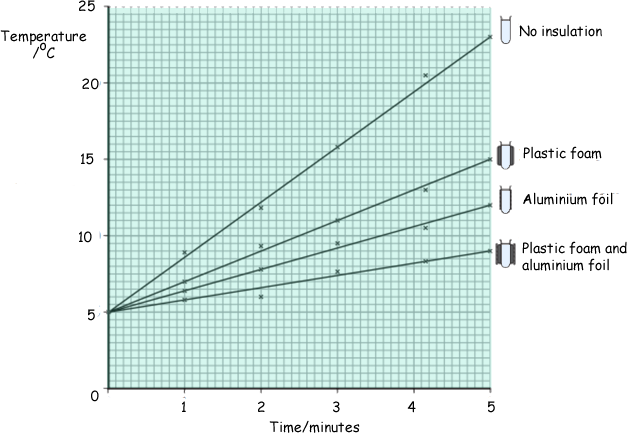Heat Questions - GCSE Level
Q1. A student had read about a glacier that had been covered in insulating material. The idea was to slow down the rate at which the glacier melts in the summer.
She investigated this idea using the apparatus shown in the diagram.

(a) These are the steps taken by the student.
 Measure 30 cm3 of cold water into a boiling tube.
Measure 30 cm3 of cold water into a boiling tube.
 Place the boiling tube 25 cm from an infra red lamp.
Place the boiling tube 25 cm from an infra red lamp.
 Record the temperature of the water.
Record the temperature of the water.
 Switch on the infra red lamp.
Switch on the infra red lamp.
 Record the temperature of the water every minute for 5 minutes.
Record the temperature of the water every minute for 5 minutes.
 Repeat with boiling tubes covered in different insulating materials.
Repeat with boiling tubes covered in different insulating materials.
(i) Why did she use an infra red lamp? (1 mark)
The lamp was a source of thermal (infra red) radiation or heat 
(ii) Name one control variable in this investigation. (1 mark)
any one from: 
• volume of water (accept amount or mass for volume)
• distance between lamp and boiling tube
• initial / starting temperature of water
• same room temperature
(iii) Give one advantage of using a temperature sensor and data logger instead of a glass thermometer to measure temperature. (1 mark)
any one from: 
• greater sensitivity / precision
• could link to a computer for
(automatic) data analysis
• could take more frequent readings
• reduces instrument reading error
Do not accept 'more reliable' (negates
mark)
Accept 'more accurate'
Do not accept easier to use on its own
(b) The results of the investigation are shown in the graph.

(i) Why did the student use a boiling tube with no insulation? (1 mark)
This acts as a control, so that a comparison can be made and you can see the difference using different insulation makes.  No mark was awarded for saying it made it a fair test.
No mark was awarded for saying it made it a fair test.
(ii) From her results, what should she recommend is used to insulate the glacier? (1 mark)
Using the (plastic) foam and aluminium foil 
(iii) Explain why the insulation recommended by the student will reduce the heat transfer from the Sun to the glacier. (2 marks)
(Aluminium) foil is a poor absorber of
thermal radiation or
(aluminium) foil is a (good) reflector
of thermal/heat/infra red radiation.'Reflects sunlight' on its
own is insufficient for a mark. 
(Plastic) foam contains traped air pckets which is a
(good) insulator. (Plastic) foam is a poor
conductor / (good) insulator was sufficient for the mark. 
(c) Explain, in terms of particles, how heat is transferred through the glass wall of a boiling tube. (2 marks)
Particles vibrate more - they vibrate with a bigger amplitude or vibrate faster or with more
(kinetic) energy 
No mark was given if you inferred that particles were not already vibrating - they want you to explain that particle vibration increases.
Energy is transferred via collisions with
other particles 
Glass does not have
free/mobile electrons - therefore saying these help transfer energy will not get you a mark.
(9 marks total)








